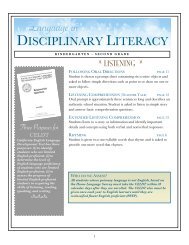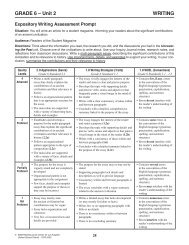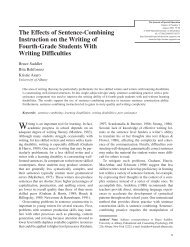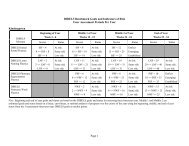Beyond Phonics: Integrated Decoding and Spelling Instruction ...
Beyond Phonics: Integrated Decoding and Spelling Instruction ...
Beyond Phonics: Integrated Decoding and Spelling Instruction ...
You also want an ePaper? Increase the reach of your titles
YUMPU automatically turns print PDFs into web optimized ePapers that Google loves.
DECODING AND SPELLING— WORD ORIGIN AND STRUCTURE 267often identified as "specific learning disabled," or "dyslexic," learn to decode<strong>and</strong> spell reasonably well using an approach based on the theories ofSamuel Torrey Orton (1937). The "Orton-Gillingham" technique placesstrong emphasis on the features of written English, primarily lettersoundcorrespondences. Gillingham <strong>and</strong> Stillman (1956) devised a structured,sequential treatment ". . . based upon the close association of visual,auditory <strong>and</strong> kinesthetic elements . . ." (p. 40). This multisensorytechnique also incorporates syllable patterns, a few key morpheme patterns,<strong>and</strong> spelling rules <strong>and</strong> generalizations. In addition, the teachers'manual contains information regarding the evolution of the English language,because the authors believed that children could learn to read <strong>and</strong>spell by underst<strong>and</strong>ing more about the language system <strong>and</strong> by incorporatinga structured, sequential alphabetic approach.The current instruction extends the Gillingham approach by takinginto account the three major word origins, <strong>and</strong> by explicitly organizingdecoding information by word origin <strong>and</strong> pattern differences. My interestin this aspect came about at Stanford University in collaboration with apublic elementary school effort developed to enhance literacy. StanfordProject READ (Calfee <strong>and</strong> Henry, 1985) emphasizes student mastery ofthe thoughtful use of language, printed <strong>and</strong> spoken, for problem solving<strong>and</strong> communication. The decoding segment of the Project provided anopportunity to combine much of the Orton-Gillingham content within ahistorical <strong>and</strong> structural framework.The Stanford Project approach (a) views the elements of reading asseparable components, (b) takes a structured <strong>and</strong> reflective approach toreading instruction, <strong>and</strong> (c) uses small group discussion as the primarymode of instruction. The Stanford Project focus on organizing conceptswas beneficial for organizing letter-sound correspondences, syllable patterns,<strong>and</strong> morpheme patterns into specific categories. The Project alsofostered the need to highlight the differences in words due to word origins<strong>and</strong> the necessity to emphasize syllabic <strong>and</strong> morpheme patterns asstrategies for decoding. The Project became the vehicle for combining alanguage-based decoding <strong>and</strong> spelling curriculum. The following propositionsprovide a context for the decoding instruction:— Simplicity is essential; human beings have trouble performing anycomplex task unless it can be organized into a small number of relativelycoherent subtasks.— There is an interrelatedness among the language skills; literate personsare distinguished not only by their ability to read, but by howthey write <strong>and</strong> speak, <strong>and</strong> even by how they listen.— Teaching the formal use of language, as contrasted with the naturallyoccurring uses, is an important goal of school, <strong>and</strong> may be themost important outcome of a reading program.— Direct teaching, coupled with small-group discussion, is a vital componentof reading instruction.






